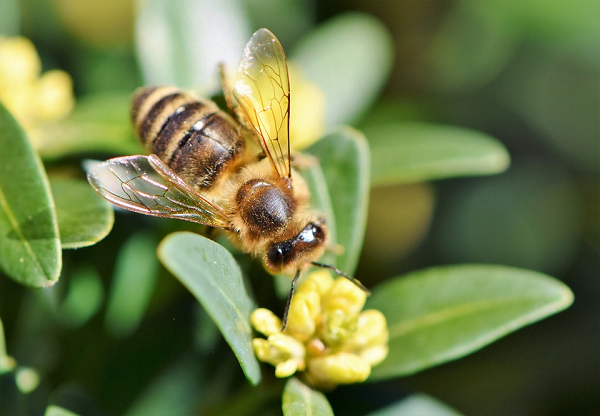A deep buzzing sound floats above your head. You watch as a skinny light-colored bee gently lands on the soft petals of a flower it hopes to collect nectar from. At first glance, it looks like any other bee in the Great Smoky Mountains, but when you look closer, you notice something unusual.
Known as the cellophane-cuckoo-bee, this specimen has a pale body with multiple brown stripes around its abdomen. It’s thought that this creature has been living in Great Smoky Mountains National Park for a while, but was only recently documented when scientists found it dwelling near charred stumps and table mountain pine seedlings in December 2020, particularly near Baskins Creek.
Some researchers, such as Will Kuhn, believe that the bee might have been enticed to live in the national park after its devastating 2016 Chimney Tops II fire which completely burned and changed the local terrain – “The fire dramatically changed the landscape taking it from forested habitat to wide open. Opened-up sites like that have had a lot of different wildflowers and other plants sprouting up than were there pre-fire and that may have attracted this bee species in.”
Historically, the bee is native to the Eastern United States and is a cleptoparasite meaning it will lay its eggs in the comb cells of another bee species. While it sounds like this would be troublesome for the environment, it’s a natural part of the ecosystem and doesn’t pose any true threats to native bees. As Kuhn mentions, “They are solitary bees and are cleptoparasites of another kind of solitary bee called a cellophane bee. The latter work hard to stock little underground cells with pollen for their young, lay an egg in each cell and line them with a cellophane-like substance (hence their name). Cellophane-cuckoo bees lay their own egg in those cells, which hatch out and ‘steal’ that larder, eating it themselves and completing their metamorphosis.”
During their exploration of the park, Kuhn and his team also came across quite a few other bee species, including one whose sole life mission is to pollinate the park’s unique yellow passionflower. They believe that in addition to the 275 bee varieties in the forest there is an assortment of other species hiding within it, like diverse parasitic wasps.
The problem isn’t just finding the bees but determining if and how both cellophane-cuckoo-bees and their relatives have been impacted by environmental concerns. Some of the biggest troubles come from extreme pesticide usage and habitat loss. Despite this, there is still hope that bee populations both in the park and the United States could rebound.
Far from this being a specifically scientific endeavor, we can in fact all do our part to assist these insects in their recovery, including by using iNaturalist which allows the community to have more involvement in documenting potentially unheard of species. By posting observations you find in the wilderness, you can assist researchers like Kuhn who will use the data to determine if biodiversity is growing or declining in a region.
The next time you head outdoors, consider being more observant of the world around you. And who knows, you might just help scientists discover a new bee species.
Rachel Kester for Times Media Mexico


